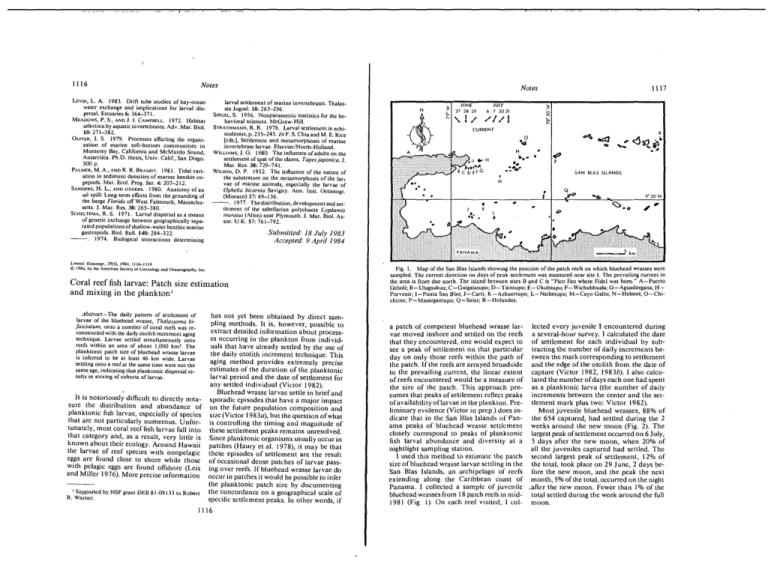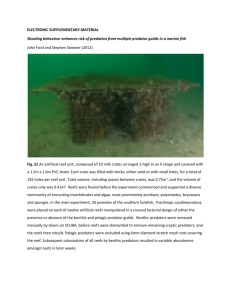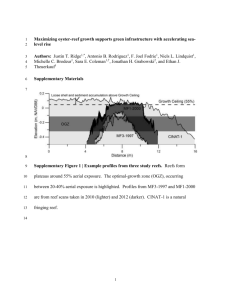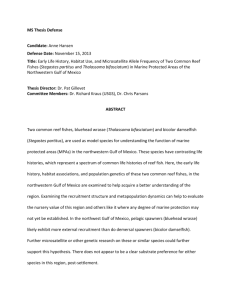Coral reef fish larvae: patch size estimation and mixing in the plankton
advertisement

Notes JUNE 27 28 29 1117 JULY 6 7 31 CURRENT .. N p ' M : ' K Q l Limnol. Oceanogr., 29(5), 1984, 1116-1119 Fig. I. Map of the Islands showing the position of the patch reefs on which blueheadwrasses were sampled. The current direction on days of peak senlement was measured near s1te I. The preva1hng eurrent Cis Feo where Fidel was the area is from due north. The island between sites Coral reef fish larvae: Patch size estimation and mixing in the plankton has not yet been obtained by direct sampling methods. It is, however, possible to extract detailed information about processes occurring in the plankton from individuals that have already settled by the use of the daily otolith increment technique. This constructed with the daily otolith increment aging technique. Larvae settled simultaneously onto aging method provides extremely precise reefs within an area of about 1,000 km• The estimates of the duration of the planktonic planktonic patch size of bluehead wrasse larvae larval period and the date of settlement for is inferred to be at least 46 km wide. Larvae any settled individual (Victor 1982). settling onto a reef at the same time were not the Bluehead wrasse larvae settle in brief and same age, indicating that planktonic dispersal results in mixing of cohorts of larvae. sporadic episodes that have a major impact on the future population composition and size (Victor 1983a), but the question of what It is notoriously difficult to directly mea- is controlling the timing and magnitude of sure the distribution and abundance of these settlement peaks remains unresolved. planktonic fish larvae, especially of species Since planktonic organisms usually occur in that are not particularly numerous. Unfor- patches (Haury et al. 1978), it may be that tunately, most coral reef fish larvae fall into these episodes of settlement are the result that category and, as a result, very little is of occasional dense patches of larvae passknown about their ecology. Around Hawaii ing over reefs. If bluehead wrasse larvae do the larvae of reef species with nonpelagic occur in patches it would be possible to infer eggs are found close to shore while those the planktonic patch size by documenting with pelagic eggs are found offshore (Leis the concordance on a geographical scale of and Miller 1976). More precise information spcciftc settlement peaks. In other words, if 1116 Abstract- The daily pattern of settlement of larvae of the bluehead wrasse, Tha/assoma bifascialum, onto a number of coral reefs was re- Geladi; B- Ulugsukun; C-Guigalatupo; D- Taintupo; E-Ukubtupo; F-Wichubhuala; G-Aguadargana; Porvenir; !-Punta Bias; J-Carti; K-Aehuertupo; L-Naibetupo; M-Cayo Gallo; N-Helmet; 0-Chtchime; P-Masargantupo; R-Ilolandes. a patch of competent bluehead wrasse lar- lected every juvenile I encountered during vae moved inshore and settled on the reefs a several-hour survey. I calculated the date that they encountered, one would expect to of settlement for each individual by subsee a peak of settlement on that particular tracting the number of daily increments beday on only those reefs within the path of tween the mark corresponding to settlement the patch. If the reefs are arrayed broadside and the edge of the otolith from the date of to the prevailing current, the linear extent capture (Victor 1982, 1983b). I also calcuof reefs encountered would be a measure of lated the number of days each one had spent the size of the patch. This approach pre- as a planktonic larva (the number of daily sumes that peaks of settlement reflect peaks increments between the center and the setof availability oflarvae in the plankton. Pre- tlement mark plus two: Victor 1982). liminary evidence (Victor in prep.) does inMost juvenile bluehead wrasses, 88% of dicate that in the San 131as Islands of Pan- the 654 capJUred, had settled during the 2 ama peaks of bluehead wrasse settlement weeks around the new moon (Fig. 2). The closely correspond to peaks of planktonic largest peak of settlement occurred on 6 July, fish larval abundance and diversity at a 5 days after the new moon, when 20% of nightlight sampling station. all the juveniles captured had settled. The I used this method to estimate the patch second largest peak of settlement, 12% of size ofbluehead wrasse larvae settling in the the total, took place on 29 June, 2 days beSan Bias Islands, an archipelago of reefs fore the new moon, and the peak the next extending along the Caribbean coast of month, 5% of the total. occurred on the night Panama. I collected a sample of juvenile ,after the new moon. Fewer than I% of the bluehead wrasses from 18 patch reels in mid- total settled during the week around the full 1981 (Fig. I). On each reef visited, I c:ol- moon. 1118 Notes ,.. <( 0 I u :f. f " g ~ ;< => 9 "' 0 ~ 0 ~ => z " Q 0 1981 MAY Fig. 2. The daily patlem ofseulement ofbluehead wrasses onto 18 reefs in the San Bias Islands. The lellers correspond to the reefs in Fig. l. Double circles-the day of collection; solid circles-new moon; open circles-full moon. Recruitment was high during the JuneJuly lunar month, permitting a detailed comparison of the daily settlement pattern between reefs. I did a three-way analysis of variance on the data in Fig. 2 (excluding settlement after IS July). The effects of the date and the reef on the number of individuals settling per day were tested (the sample size for each reef was also tested to remove the variance accounted for by the unequal sample sizes from different reefs). The date had a highly significant effect on numbers settling per day (P < 0.000 I), while the reef had no significant effect on the number of individuals settling per day (P > 0.44). On most reefs examined, the two highest peaks of settlement that month were on 29 June and 6 July, although which one was higher varied between reefs. With a single exception, all other reefs experienced peak settlement within a day of these two dates. For the exception only the second highest peak was on some other date. Since there is some small error associated with counting daily L it seems likely that larval recruits were settling simultaneously onto all of the reefs (an area 46 x 16 km, or 736 km 2 ). Since the prevailing cuiTent comes from the north in this area of Panama, it can therefore be inferred that the patch width of bluehead wrasse larvae was at least 46 km. Newly settled bluehead wrasses probably metamorphose in hiding for their first 5 days on the reef, as has been demonstrated for another coral reef wrasse, the slippery dick, Halichoeres bivillatus (Victor 1983b). Therefore I sampled only some of the reefs late enough to capture juveniles that settled during the July-August lunar peak of settlement (reefs ABEHIJKLNO). During this period peak settlement occurred on 30 and 31 July on most of the reefs with large samples (i.e. not on reefs BEJKL). Since the easternmost reefs (PQR) were not sampled late enough to include this settlement, the minimum patch width estimate for this settlement is only 20 km. Since peaks of settlement tended to occur on all reefs simultaneously, the most parsimonious explanation would be that bluehead wrasse larvae occur in patches at least as wide as the area surveyed. Smaller patches of larvae could conceivably have moved through the area and happened to pass over all the reefs each time. However, as the prospective patch size gets smaller, this coincidence becomes progressively more unlikely. Since the reefs surveyed are arrayed broadside to both the prevailing onshore current in the area and the current measured during these settlement peaks (Fig. I), a large patch size is much more likely. The patch of larvae moving in on a particular day was internally heterogeneous, since the magnitude of s'ettlement peaks was not consistent between nearby reefs; for example, reef G received its largest settlement on 29 June Notes and its second largest on 6 July, which was less than half the size of the 29 June peak, while reefD, <I km away, received its largest settlement on 6 July and its second largest on 29 June, and the 29 June peak was only a third the size of the 6 July peak. It is possible that rather than being passively delivered to the reef by circulating water masses, bluehead wrasse larvae are able to choose actively when to move inshore, either by swimming or by maneuvering themselves into favorable onshore currents. If this is true, the cues for such behavior must operate over an area of at least the size surveyed. This would suggest a different form of patch, as would the possibility of passive delivery by a front rather than a patch (for example by episodic internal wave trains: Shanks 1983), but both of these phenomena would still involve the simultaneous presence of larvae on a front at least as wide as the area surveyed. There is some lunar influence either on these cues or on passive delivery of patches of larvae, for the likelihood of any settlement during the week around full moon was very low. It is not, however, under precise celestial control, as days of settlement did not consistently fall on certain days of the lunar month. Gross weather and water conditions did not appear to trigger settlements, since peak settlements occurred on both clear and rainy days and generally at normal turbidity readings. The bluehead wrasse larvae settling on any particular day were not of the same age. The variance in age for those larvae settling on a single day onto a single reef was not significantly different from the total variance known for the species [samples with settlement of more than I 0 individuals onto a single reef on a single day vs. pooled sample; nine F-tests, only one significant (P < 0.05), range in age= 37-72 days]. Patches of larvae are therefore made up of many separate cohorts of individuals spawned over a number of weeks that somehow aggregate by active or passive means before settlement. As a result, the juveniles that 1119 settle together are probably not closely related. This is the first demonstration that planktonic dispersion of eggs does indeed mix cohorts oflarvae before settlement and has important ecological ramifications. If larvae are settling simultaneously over very large areas, then the cues for settlement cannot be localized to a single reef. The notion that individuals settle from a pool of superabundant larvae onto reefs in response to local changes in the supply of food or space (Smith and Tyler 1973; Sale 1978) is therefore inconsistent with my findings. Benjamin C. Victor Department of Biological Sciences and Marine Science Institute University of California Santa Barbara 93106 References HAURY, L. R., J. A. McGowAN, AND P. H. WIEBE. 1978. Pauems and processes in the time-space scales of plankton distributions, p. 277-327.Jn J. H. Steele [ed.], Spatial patlems in plankton communities. Plenum, LEIS, J. M., AND J. M. MILLER. 1976. Offshore dis· tributional patlerns of Hawaiian fish larvae. Mar. Bioi. 36: 359-368. SALE, P. F. 1978. Coexistence of coral reef fishes-a lollery for living space. Environ. Bioi. Fishes 3: 85-102. SHANKS, A. L. 1983. A mechanism for the onshore migration of crab larvae. Mar. Ecol. Prog. Ser. 13: 311-315. SMirll, C. L., AND J. C. TYLER. 1973. Population ecology of a Bahamian suprabenthic shore fish assemblage. Am. Mus. Novit. 2572. 38 p. VICTOR, B. C. 1982. Daily otolith increments and recruitment in two coral-reef wrasses, Tha/assoma bifasciatum and Halichoeres bivillatus. Mar. Bioi. 71: 203-208. - - . l983a. Recruitment and population dynam· ics of a coral reef fish. Science 219:419-420. - - . i983b. Setllement and larval metamorphosis produce distinct marks on the otoliths of the slippery dick, /lalichoeres bivillatus, p. 47-52. In The ecology of deep and shallow coral reefs. Symp. Ser. Undersea Res., v. I. Office of Undersea Research, NOAA. Submi/led: 27 October 1983 Accepted: 30 March 1984







